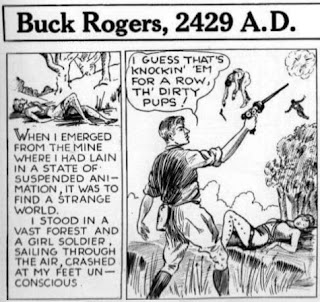 Popular culture is popular for only a while. Then new generations come along and have their own ways of doing things. They don’t know about things that were commonplace at one time. I’ve had to explain to younger people who Al Jolson was (and he was before my time), and not only how a rotary dial phone works, but why phone numbers had letters and numbers.
Popular culture is popular for only a while. Then new generations come along and have their own ways of doing things. They don’t know about things that were commonplace at one time. I’ve had to explain to younger people who Al Jolson was (and he was before my time), and not only how a rotary dial phone works, but why phone numbers had letters and numbers.
So it is with many old terms and sayings, too. People today may never have heard of them, though they were known 100 years ago. To your right is a frame from a Buck Rogers comic strip. Even though Buck is in the future, he uses an obsolete “oath” as they called it then. I’ve heard “You dirty dog!” before. No one says it today; people are less genteel and think nothing of using foul language our forefathers wouldn’t have dreamed of. But “The dirty pup!” is an old one that’s a new one on me.
It was common. Here it is in a Salt Lake City newspaper, 1908.
Portland, Oregon paper, 1916.
1915. Los Angeles Times.
This is from 1910.
St. Paul, Minnesota, 1892.
Here’s Bosko in Bosko’s Picture Show (1933).
Yeah, it’s possible he didn’t say “The dirty pup!” at the “cur” on the screen. But, to me, it’s more likely he did than fanciful tales of shouting a four-letter word that is far too common today but never used in polite society in an earlier day. Regardless, some people will believe it anyway because “slipping something past a censor” makes a much better story. Today, it seems, there are those who are quite prepared to accept and cling to fanciful tales as fact and reject everything else.





















































